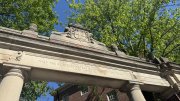An unusual Deans Letter on the Finances of the Faculty, presented to the Faculty of Arts and Sciences (FAS) on October 17, during its first meeting of the year, details a significant structural deficit consisting of expense that has been permanently committed but not permanently funded. The letter, one in a series planned by interim dean Jeremy R. Knowles, largely confirms the darkening view of FASs fisc outlined by its Resources Committee last January (see Fraught Finances, March-April 2006, page 61).
But Knowles did not explicitly embrace the assumptions made then about how the gap could be filled through greater reliance on endowment distributions, future fundraising, and recovery of indirect costs (overhead) on federally sponsored research. Instead, he sought to provide clear information so the faculty could face the same horizon of challenges together and then make appropriate financial choices in concert with my less impermanent successorthe next FAS dean, to be appointed by Harvards next president. (The text of the letter appears at www.fas.harvard.edu/home/administration/communications.html.)
In his letter and presentation, Knowles stressed the progress FAS has made, in pursuit of which it has increased costs. [W]e have advanced remarkably in the last few years, growing the faculty, entering new fields of enquiry and strengthening others, and improving the support and the opportunities available to our students, he wrote. The number of regular faculty members, for instance, has risen steadily, jumping from 663 to 719 during the past three academic years alone.
 |
| Graph courtesy of FAS Dean's Letter / October 2006 |
In answer to a question, he described FAS as being in a very strong position, enjoying enormous support from its endowment, valued at $2.2 billion when Knowles first became dean in 1991, and at $13.2 billion now. The share of FAS income from endowment distributions has risen from one-third to nearly one-half during that period.
But even those strengths cannot support the full expense of augmenting the faculty or of equipping them for their work, particularly in the sciences. The cost of new buildings recently completed or still under construction totals $740 million, nearly all of which will be borrowed. FASs outstanding debt will nearly triple, to $1.2 billion from $450 million today. Interest and principal payments and operating costs just for the new construction are forecast to rise nearly tenfold, from $8.5 million in fiscal year 2006 to $81 million in fiscal year 2010. In other words, as Knowles wrote, [T]he most significant elements of our rising expense budget are the costs of bringing new colleagues to Harvard, sustaining them, and providing space and facilities in which they can flourish. Hence, in response to a Resources Committee query about whether FAS would become house-poor, he wrote, The honest answer is yes, for quite a while.
Other costs are rising, too: financial aid, efforts to promote study abroad, new student facilities, and further changes stemming from the undergraduate curriculum review. Therefore, our projected deficits are not short-term gaps that can be filled by temporary belt-tightening. As shown in the accompanying graph, FAS is staring at deficits beginning now, and reaching as much as $50 million to $80 million annually within two more years.
Knowles was able to report some unexpectedly good news: instead of a projected $40 million deficit in the fiscal year ended last June, FAS recorded a modest surplus of $4.9 million (revenue totaled $958 million, up 10.4 percent from fiscal year 2005). Some of that reflects slower-than-anticipated hirings of additional faculty members. Cost controls and redirection of certain reserves and fund balances contributed, too: Knowles estimates gains of $7 million to $9 million in the current year from such efforts, and is searching for $5 millon to $7 million more during the next three years. It also appears that FAS was able to take better advantage of extra, strategic distributions from the endowment for purposes approved by the Corporation, and that faculty members did relatively well in securing external grants for their research.
Looking ahead, Knowles cautioned colleagues to decide how much further we wish to grow, even as the faculty tries to alter its disciplinary balance somewhat. That is, having identified a need to grow in life science and engineering, and having taken on debt to accommodate additional professors in those fields, it would be irrational now to halt the recruitment of colleagues who will both contribute to our overall intellectual goals, and (more practically) secure grantsthe indirect cost recovery on which will help to pay for the new construction.
In other words, having analyzed prospective long-term deficits, Knowles does not prescribe an overall solution. He intends, rather, to help hold the line until his successor plots new priorities. For the foreseeable future, then, FAS is committed to faculty growth and the associated costs of new facilitieswith the hope that better-than-forecast outcomes from any or all of its sources of revenue will lessen the pain of its house-poor period.





